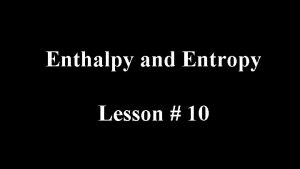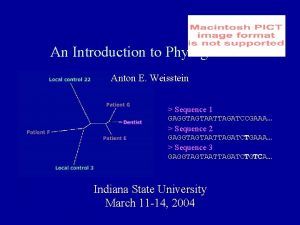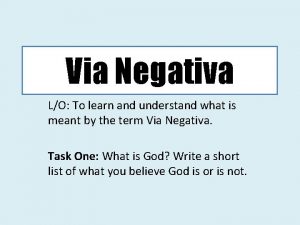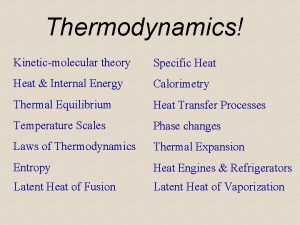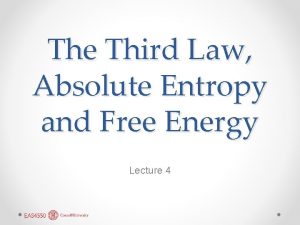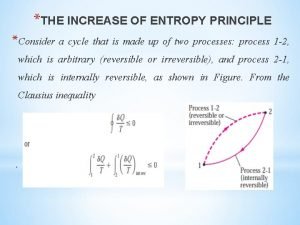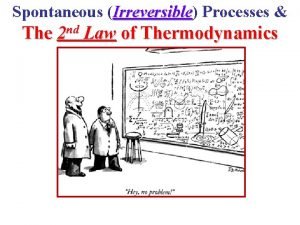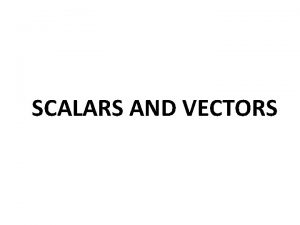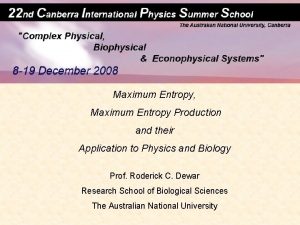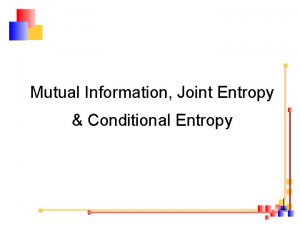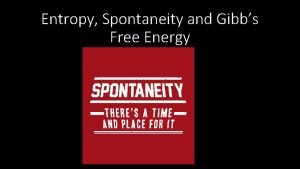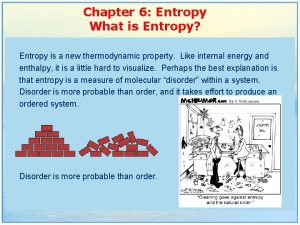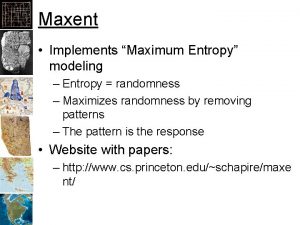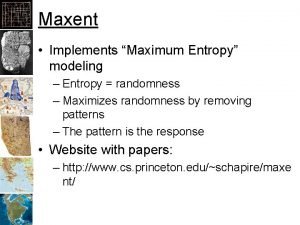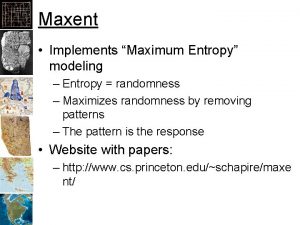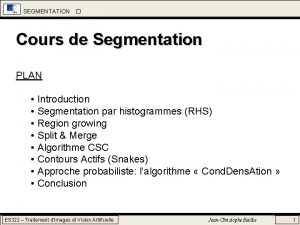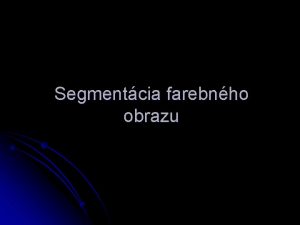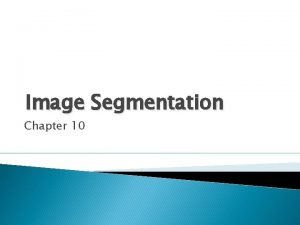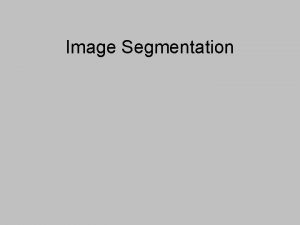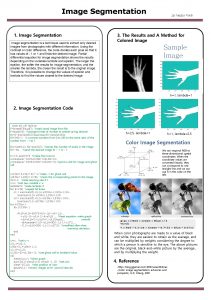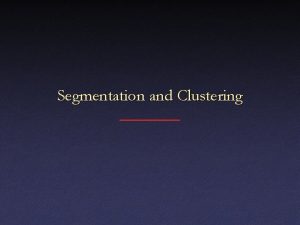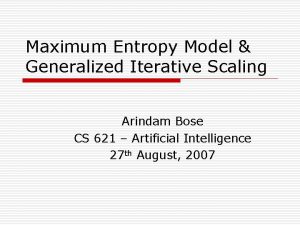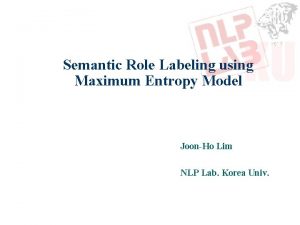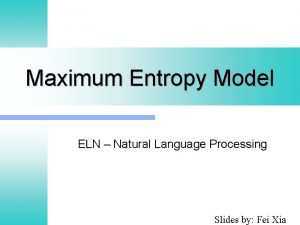Segmentation via Maximum Entropy Model Goals Is it



















- Slides: 19

Segmentation via Maximum Entropy Model

Goals • Is it possible to learn the segmentation problem automatically? • Using a model which is frequently used in NLP tasks - the Maximum Entropy model • Finding features compatible to the segmentation task

Segmentation as a tagging problem • Attach each pixel one of two tags: is it an edge between segments or not. • Use a tagged set of images to build a statistical model. • Given a new image we want to find the most probable tag for each pixel using this model

Maximum Entropy • We want to build a statistical model which makes as few assumptions as possible. • Entropy – the uncertainty of a distribution. The level of “surprise”. • So, we need a statistical model with the highest entropy possible.

Maximum Entropy - Definitions • Event – a couple (p, t) where p is a pixel and t is its tag. • Feature – elementary piece of evidence that link p to t. A feature has a real value. • The decision about a pixel is based only on the features active at that point. • Looking for conditional probability P(p|t, f)

Maximum Entropy – building the model • We use a tagged training set to build the statistical distribution. • Constrains on the distribution: – The expectation for each feature should be equal to its expectation in the training set. – Maximizing the Entropy over all possible distributions. • We get an optimization problem which can be solved using Lagrange multipliers (weights).

opennlp maxent • Machine learning package compatible for NLP tasks. • Used for training maximum entropy models. • All is left is adjusting it to work with images and finding a set of features compatible for the segmentation task.

The Berkeley segmentation database • Consists of 300 images and the corresponding segmentation maps. • The segmentation maps where constructed by humans. • The database is divided into a train set (200) and a test set (100).

The Berkeley segmentation database - example

Features • I focused on brightness and texture features (technical problems): – Brightness difference with surrounding pixels – Gradient magnitude using the Prewitt operators. – Canny edge detection results

Features – cont. Local Binary Partition Measure: For each pixel p, create an 8 -bit number b 1 b 2 b 3 b 4 b 5 b 6 b 7 b 8 where bi=0 if neighbor i has value less than or equal to p’s value and 1 otherwise. For example: 1 8 2 3 100 101 103 40 50 80 50 60 90 7 6 4 5 11111100

Features – cont. Laws Texture Measure: • Basic texture matrices: L 5 = [ 1 4 6 4 1 ] S 5 = [ -1 0 2 0 -1 ] E 5 = [ -1 -2 0 2 1 ] R 5 = [ 1 -4 6 -4 1 ] • Creating a 9 feature vector for each pixel: L 5*E 5/E 5*L 5 S 5*R 5/R 5*S 5 R 5 R 5 L 5*R 5/R 5*L 5 L 5*S 5/S 5*L 5 S 5 S 5 E 5*S 5/S 5*E 5 E 5*R 5/R 5*E 5 E 5 E 5 • For the current pixel calculating the distance to surrounding pixels

Results

Results

Results

Results

Discussion • The model is basic but it has managed to find segments at some level. • Best result are found where there is an object with a contrasting background or radical difference of texture. • The model had succeeded in filtering edges which are not segments. For example:

Discussion

Feature Work • More features • A compatible package for images • Search algorithm for finding the best sequence • Working with color images • Special learning: by one person, by category etc.
 Strategic goals tactical goals operational goals
Strategic goals tactical goals operational goals Strategic goals tactical goals operational goals
Strategic goals tactical goals operational goals Minimum enthalpy maximum entropy
Minimum enthalpy maximum entropy Absolute maxima and local maxima
Absolute maxima and local maxima Maximum parsimony vs maximum likelihood
Maximum parsimony vs maximum likelihood Maximum likelihood vs maximum parsimony
Maximum likelihood vs maximum parsimony Via crucis y via lucis
Via crucis y via lucis Via positiva and via negativa
Via positiva and via negativa Que es el vialucis
Que es el vialucis Helicopoda
Helicopoda Via erudita e via popular
Via erudita e via popular General goals and specific goals
General goals and specific goals Motivation in consumer behaviour
Motivation in consumer behaviour Entropy equation temperature
Entropy equation temperature Absolute entropy
Absolute entropy Increase in entropy principle
Increase in entropy principle Reverse entropy
Reverse entropy What is the change of entropy in an irreversible process
What is the change of entropy in an irreversible process Second law of thermodynamics
Second law of thermodynamics Entropy is scalar or vector
Entropy is scalar or vector


